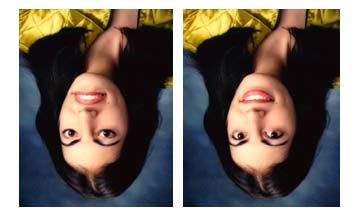
Go here for a striking illusion, i.e., to see what happens when these pictures are turned right side up. That’s Tania in the pictures, btw.
OK, so I had titled this entry “Tania Lombrozo, I Love You,” but that was more than a tad over the top (and anyway my heart belongs to this woman forever). Nevertheless I cannot help but feel a surge of intellectual affection — philia — at learning that someone is trying to understand the puzzle of when and why humans infer intelligent design, or more generally, default to teleological modes of explanation, whether correctly or not. (It’s that last bit that should be very useful to design theorists; see below.)
Tania Lombrozo is an assistant professor of psychology at UC-Berkeley, with an academic background in both the philosophy of science (Stanford) and cognitive psychology (Harvard). Her new paper, “Inferring design: evidence of a preference for teleological explanations in patients with Alzheimer’s disease,” Psychological Science 18 (Nov 2007):999-1006, presents data about the following:
Unlike educated adults, young children demonstrate a “promiscuous” tendency to explain objects and phenomena by reference to functions, endorsing what are called teleological explanations. This tendency becomes more selective as children acquire increasingly coherent beliefs about causal mechanisms, but it is unknown whether a widespread preference for teleology is ever truly outgrown. The study reported here investigated this question by examining explanatory judgments in patients with Alzheimer’s disease (AD), whose dementia affects the rich causal beliefs adults typically consult in evaluating explanations. The results indicate that unlike healthy adults, AD patients systematically and promiscuously prefer teleological explanations, suggesting that an underlying tendency to construe the world in terms of functions persists throughout life. This finding has broad relevance not only to understanding conceptual impairments in AD, but also to theories of development, learning, and conceptual change. Moreover, this finding sheds light on the intuitive appeal of creationism.
Yeah, I know: Alzheimer’s and creationism — cue the jokesmiths at the Panda’s Thumb.
But Lombrozo points out that teleological or design explanations are often correct: watches do have watchmakers. So what distinguishes erroneous and correct design inferences? Knowing the circumstances under which humans incorrectly infer design may help ID theorists guard against hard-wired teleological bias. Correct (sound) and incorrect (unsound) design inferences are two sides of the same coin. Discovering how we may err in inferring design is essential to knowing when we’ve made such inferences reliably.
Truth-In-Plugging-Someone-Else’s-Work Statement: Tania Lombrozo is NOT herself sympathetic to ID. See this paper.